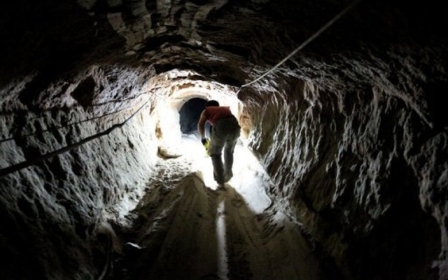Thousands in Gaza mourn Hamas members killed in tunnel collapse

Tens of thousands of Palestinians took part in the funeral for seven members of Hamas who were killed earlier this week while doing repair works on an underground tunnel northeast of the Gaza strip.
Local news agencies said that as many as 250,000 people, including many Hamas militants, may have turned out on the streets.
Hamas’s armed wing, the al-Qassam Brigades, said that its members died while restoring a tunnel that had been used for ground operations against the Israeli army during the 2014 summer offensive on the strip.
Eight members were initially reported missing on Tuesday, but a press statement from Hamas two days later confirmed the deaths of seven men. Four other members managed to escape as the tunnel collapsed after several days of heavy rain.
"Al-Qassam Brigades mourn the death of seven Qassam members who were (killed) during their work inside resistance tunnels in Gaza," the armed wing posted on their Twitter account.
According to the statement, several members in the group belonged to an elite force. Most had participated in operations against Israeli forces during the 51-day offensive in 2014.
Hamas identified those who died in the tunnel as Thabet al-Rifi, Ghazwan al-Shubaki, Izz al-Din Qassem, Wassim Hassouneh, Mahmoud Bassal, Nidal Odeh, and Jaafar Hamadeh.
The funeral started at the Omari Mosque in Gaza City and was led by political leaders from Hamas.
In a statement released on Friday, Hamas called on Palestinians to support armed resistance to Israel.
“Those men died as they were preparing for anti-occupation resistance,” the statement read. “They have sacrificed their souls to defend their land and holy sites,” adding that the men represented the “source of the nation’s honour”.
Tunnel collapses have previously occurred in the coastal strip, which has seen three wars with Israel since 2008.
As the Israeli-Egyptian blockade on the coastal enclave enters a ninth year, tunnels remain a lifeline for the majority of Gaza’s 1.8mn people, who rely on smuggled good such as food, medicine, and infrastructure materials like concrete and fuel.
At the end of 2014 however, Egypt began the construction of a buffer zone in the northern Sinai Peninsula, on the border with Gaza, destroying hundreds of tunnels it said were used for smuggling weapons and other items.
While the tunnels south of the strip are generally used for smuggling materials, the tunnels in the north are used for military purposes.
After Israel destroyed much of the tunnel infrastructure in 2014, Hamas has since reportedly been reconstructing them along the border of the strip.
Stay informed with MEE's newsletters
Sign up to get the latest alerts, insights and analysis, starting with Turkey Unpacked
Middle East Eye delivers independent and unrivalled coverage and analysis of the Middle East, North Africa and beyond. To learn more about republishing this content and the associated fees, please fill out this form. More about MEE can be found here.




